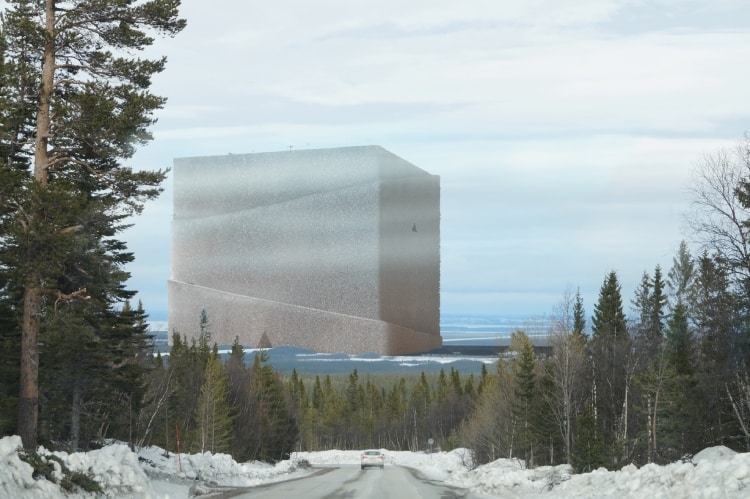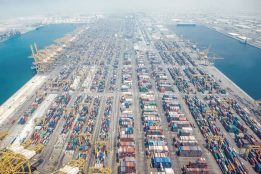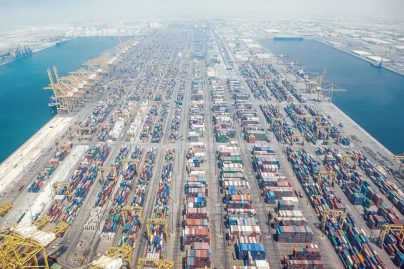Take a look at some of the innovative plans for the future
Thu 30 Dec 2021
Predictions for the future have not always been entirely accurate.
If sci-fi author Philip K. Dick’s classic novel “Do Androids Dream of Electric Sheep?” had been prophetic, humanoid robots would live among us by now, almost indistinguishable from people. And if Keanu Reeves’ 1995 movie “Johnny Mnemonic” had come to pass, human couriers would, by 2021, have been able to store gigabytes’ worth of sensitive corporate data in brain implants.
You may, therefore, wish to take today’s boldest design proposals with a pinch of salt. Indeed, this year has seen architects, designers and entrepreneurs pushing the boundaries of what might one day be possible, including designs for rain-catching skyscrapers and the Tesla Bot android (maybe Dick’s ideas weren’t so far off the mark, after all).
Speculative to varying degrees, these are some of 2021’s most eye-catching visions of the future.
A sustainable desert city
Billionaire Marc Lore this year outlined his vision for Telosa, a “new city in America” intended to house 5 million people. The 150,000-acre metropolis, built from scratch in the desert, promises eco-friendly architecture, sustainable energy production and a drought-resistant water system. A so-called “15-minute city design” will meanwhile allow residents to access their workplaces, schools and amenities within a quarter-hour commute of their homes.
Now, the former Walmart executive just needs funding — and somewhere to build. Planners have yet to announce an exact location, but possible targets include Nevada, Utah, Idaho, Arizona and Texas, according to the project’s official website.
Robot Forest Rangers
Amid the ongoing threat of deforestation around the world, Israel-based industrial design student Segev Kaspi has envisaged three autonomous forest rangers named Rikko, Chunk and Dixon. Collectively known as Forest Ranger Druids, the droids would be designed to support reforestation and sustainable forest management.
The three robots perform differing proposed functions: Chunk would thin, prune and mow vegetation; Dixon would plant seedlings and cuttings, and Rikko would collect information and provide mapping and monitoring services. Although just a concept, for now, the project offers a “possible solution for an urgent problem,” Kaspi wrote on his website.
A 100% recyclable BMW
With grand visions of becoming “the world’s most sustainable manufacturer in the individual premium mobility space,” BMW this year unveiled designs for a four-seater concept car made entirely from recycled — and 100% recyclable — materials. Dubbed the BMW i Vision Circular, the proposed vehicle will be built using repurposed aluminium, steel and plastic, alongside certified bio-based materials.
The manufacturing process will use 3D printing to reduce waste and offcuts. And, in keeping with forward-looking circular design principles, the German carmaker has also considered the vehicle’s lifespan, which BMW claims will be extended thanks to detachable components that can easily be swapped out for new ones.
Without exterior paintwork, leather or chrome, the concept car looks suitably futuristic and could launch in 2040, according to a news statement.
A new way to gather outdoors
Inspired by banyan trees and hot air balloons, Ephemeral Station offers a high-tech way for people to gather safely in harsh environments. As well as being a “sculptural and iconic element,” as the designers Of. The studio described it, the proposed self-supporting module has a variety of possible uses, from hosting desert campouts and events like music festivals, to serving as temporary accommodation in extreme conditions.
In addition to offering sun protection to those gathering beneath, the cloud-like structure would generate energy via photovoltaic cells while its “legs” tunnel beneath the surface to collect groundwater for drinking or internal cooling. Ephemeral Station is also designed to move and transform with the conditions, expanding and contracting with changing temperatures, to give it the appearance of a living, breathing organism.
Floating mobile houses
As part of an initiative to imagine life in 2050, Sony’s in-house design group, Creative Center, dreamed up a series of mobile homes floating in Tokyo Bay. Responding to the threat of rising sea levels, the designers imagined future homes equipped with power and water systems for a new breed of “sea nomads.”
Self-propelled by water jets, each home would come with filters that clean water for drinking as the residence moves through the bay. The structures come with solar panels on their roofs, while autonomous energy tanks would float nearby, attaching themselves to homes in need of additional power.
With separate outer and inner shells to reduce the impact of waves, the homes could also connect to one another to form a larger, more stable structure during storms. It’s not the first floating community that has been proposed — Bjarke Ingels Group revealed an ambitious United Nations-based design for “Oceanix City” in 2019, which could house 10,000 residents.
World’s largest timber building
Buildings — and even skyscrapers — made with engineered timber are an increasingly common sight in cities across Europe and North America. But for Anders Berensson Architects, the Swedish firm behind a “science fiction” plan to construct the world’s largest entirely wooden building, the proposed project is less about the possibilities of architecture and more about finding sustainable solutions for Sweden’s timber industry. Each year, the industry accounts for 970,000 tons of CO2 emissions, according to the Skogforsk research institute.
Dubbed the Bank of Norrland, the building is both made of wood and a place to store it: it has been designed with room for up to 900 million logs for use in construction or manufacturing. And because trees absorb carbon dioxide through their lifetime, the “bank” also stores those emissions trapped within the timber.
The architects say their proposal would provide local farmers with reliable income while preventing logs from being burned, turned into biofuels or left to decompose, all of which would return the CO2 to the atmosphere.
The Tesla Bot
Unveiled by Elon Musk at Tesla AI Day in August, the Tesla Bot is part of the carmaker’s drive to apply its AI research beyond its vehicle fleet.
Described as a “general purpose” bi-pedal humanoid, the 5-foot-8-inch robot will weigh 125 pounds and be capable of deadlifting 150 pounds. The Tesla Bots’ precise use and the timeline for completion remain shrouded in mystery, but it is being designed to perform tasks that are “unsafe, repetitive or boring,” with Musk suggesting that the technology could ultimately address future labour shortages.
And for those worried about a “Terminator”-style rise of the machines, Musk assured attendees at the presentation that the bots can only move at 5 miles per hour, meaning “you can run away from it and, most likely, overpower it,” he half-joked
Airdropped emergency shelters
When the London Design Biennale put out a global call for designs to address issues in “an age of crisis,” the Radical Gravity project proposed a futuristic solution for people displaced by natural disasters, conflict or climate change: emergency shelters that can be airdropped into dangerous or hard-to-reach places.
Developed at the Architectural Association’s Design Research Lab in London by students Angelina Kozhevnikova, Konuralp Senol and Kyungha Kwon at the Spyropoulos Studio, the proposal envisages an aeroplane releasing up to 500 units, known as Gravitons, that form parachutes in mid-air. After safely landing, they would, in theory, auto-inflate into networks of habitable pods designed to collect rainwater and generate energy.
Rain-harvesting skyscrapers
In the bleak future envisioned by South African firm BPAS Architects — whereby the Sahara Desert has expanded tenfold, and oceans cover over 80% of the Earth’s surface — water is exceptionally hard to come by. In fact, in this dystopian scenario, the Earth’s surface is so hot that any rainfall evaporates hundreds of meters before reaching the ground.
The architects’ solution? A water-harvesting skyscraper that reaches 1,000 meters (3,281 feet) into the sky and collects moisture before it evaporates. The water is then transported down the length of the skyscraper to underground storage facilities, after which solar-powered pumps transport it to farming areas or people’s homes for drinking and sanitation.
Source: Agencies

 Apr 19 2024
Apr 19 2024













